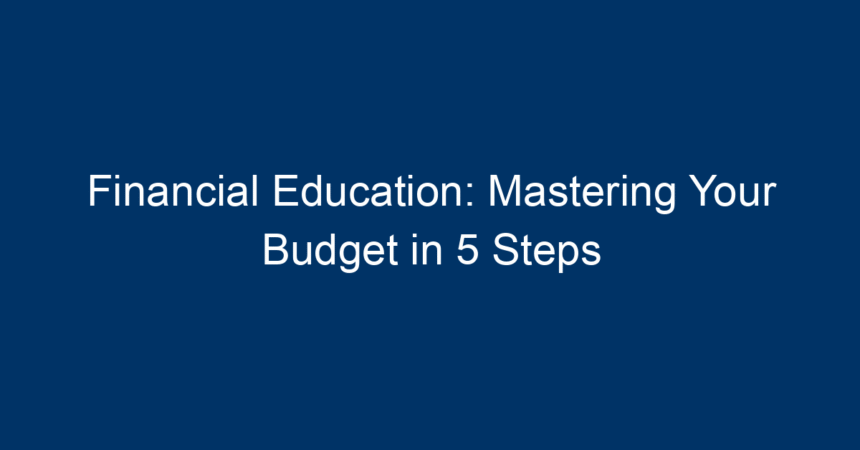In today’s fast-paced world, understanding your finances can be a game changer. Financial education is not just for accountants or economists; it’s essential for everyone who wants to take control of their financial future. One of the most critical aspects of financial education is mastering your budget. A well-planned budget helps you make informed decisions, avoid debt, and save for future goals.
This article will guide you through five actionable steps to help you master your budget effectively, ensuring that you gain confidence and clarity in your financial journey.
Why Financial Education is Essential
Before diving into budgeting, it’s crucial to appreciate the importance of financial education. It lays the foundation for making informed decisions about money management, investments, and savings. With a solid understanding of personal finance, you can:
- Avoid Debt: Knowledge equips you to navigate credit, loans, and interest rates wisely.
- Enhance Savings: Understand how to maximize your savings potential.
- Invest Wisely: Make educated choices about where to allocate your money.
By enhancing your financial education, you’re preparing yourself for a more secure future where your money works for you.
Step 1: Understand Your Income and Expenses
Assess Your Financial Situation
The first step in mastering your budget is to have a clear picture of your financial situation. Begin by gathering all forms of income, including your salary, freelance earnings, and any other cash inflows.
Track Your Income
- List All Income Sources: Document all your income streams.
- Calculate Your Monthly Total: Sum up your total monthly income to create a baseline.
Categorize Your Expenses
Next, break down your expenses into two main categories: fixed and variable:
- Fixed Expenses: These include rent or mortgage, insurance, and loan payments—items that rarely change month-to-month.
- Variable Expenses: These are discretionary spending categories like food, entertainment, and shopping.
Use Budgeting Tools
Consider using budgeting apps or spreadsheets to organize your income and expenses. Tools like Mint, YNAB (You Need a Budget), and Personal Capital can help automate this process and make it more visual.
Step 2: Set Your Financial Goals
Short-Term vs. Long-Term Goals
Clearly defined financial goals are essential for effective budgeting. Break your goals down into short-term (1 year or less) and long-term (more than a year) objectives.
Short-Term Goals
- Emergency Fund: Aim to save 3-6 months’ worth of living expenses.
- Debt Repayment: Create a plan to pay off credit cards or loans systematically.
Long-Term Goals
- Home Ownership: If purchasing a house is a priority, start budgeting for a down payment.
- Retirement Savings: Contribute to a 401(k) or IRA to secure your financial future.
Make Your Goals SMART
Goals should be Specific, Measurable, Achievable, Relevant, and Time-bound (SMART). For instance, instead of saying, "I want to save money," specify that you’ll save $2,000 for a vacation by a specific date.
Step 3: Create Your Budget
Choose a Budgeting Method
Now that you understand your income, expenses, and goals, it’s time to create your budget. Different methods work for different individuals, so choose one that resonates with you:
- Zero-Based Budgeting: Every dollar is assigned a purpose. Your income minus expenses equals zero at the end of the month.
- 50/30/20 Rule: Allocate 50% of your income to needs, 30% to wants, and 20% to savings and debt repayment.
- Envelope System: Use physical envelopes for different spending categories to visually track your spending.
Allocate Funds Wisely
Ensure that your budget reflects your financial goals. For example, if debt repayment is a priority, allocate extra funds from your discretionary spending to pay down debt faster.
Step 4: Monitor and Adjust Your Budget Regularly
Regular Check-Ins
Creating a budget is not a one-time event. Regularly review your budget to see if you’re on track. Set aside time weekly or monthly to assess your spending and adjust where necessary.
Use Financial Apps
Leverage technology to keep an eye on your budget. Many budgeting apps send alerts for overspending, helping you stay accountable.
Be Flexible
Life is dynamic, and so are your financial circumstances. Unexpected expenses, changes in income, or alterations in financial goals may require you to revise your budget. Don’t hesitate to make adjustments.
Step 5: Educate Yourself Continually
Read and Learn
Financial education is an ongoing process. Continue to study budgeting techniques, investment strategies, and personal finance trends. Numerous resources are available, including:
- Books: Titles like "The Total Money Makeover" by Dave Ramsey offer great insights.
- Podcasts: Programs like "The Dave Ramsey Show" provide practical financial advice.
- Online Courses: Websites like Coursera and Udemy offer courses on personal finance concepts.
Join a Community
Consider joining community groups focused on financial education. Platforms like Reddit, Facebook Groups, or local meet-ups provide a space to share ideas, tips, and experiences related to budgeting and financial planning.
Conclusion: Take Action
Mastering your budget through these five actionable steps will pave the way for better financial education and ultimately a more secure financial future. Start by understanding your current financial situation, set clear goals, create a sensible budget, monitor it continually, and commit to ongoing education.
Remember, financial education is not just about knowing facts; it’s about applying this knowledge to foster financial wellness. Each small step you take towards mastering your budget can lead to significant changes in your financial landscape. So, embark on this journey today—your future self will thank you!
Embrace the challenge, engage with the process, and witness the positive transformations in your financial life. Happy budgeting!




